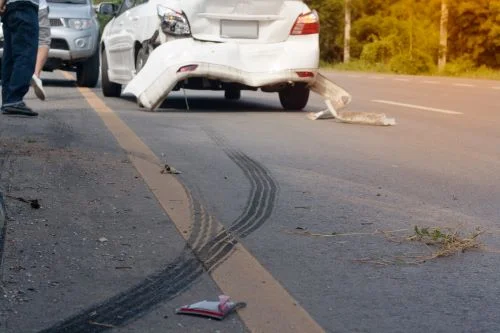
Rear-end collisions are the most common vehicular collisions on the road. Every year, between 30 to 40% of accidents between vehicles are rear-enders.
Granted, rear-enders also have a low mortality rate, sitting at about 6%. But when you survive a rear-end collision only to be slapped with medical bills for whiplash and repair costs of your vehicle (not to mention the injuries of other passengers), they can still be a huge problem.
When you’ve been in a rear-end collision, you’re likely going to need help to cover your expenses. Contact Valley Law Accident and Injury Lawyers today, and we’ll do a no-obligation, zero-cost case evaluation for you.
Why Do You Need a Salt Lake City Rear-End Collision Attorney for Your Accident?
Utah’s laws surrounding compensation after a rear-end collision can be confusing at times. This is because even if most people get that Utah is a no-fault state, there are often other factors people don’t realize can increase the amount accident victims can pursue.
Lawyers, on the other hand, have the advantage of information. Lawyers know these tricks and secrets and use them to better clients’ interests.
We Know the Law
While understanding the entirety of injury law is an advantage when making damage claims, nobody really expects the average person to be a master at it. Certainly, insurance companies don’t expect it from their clients.
Insurance providers are, first and foremost, out to run a business. You might have a family to feed, thus the need for a claim, but they run a system with employees to pay, a reputation to uphold, and investors to benefit.
And while they will hand out money when presented with evidence backing a claim, they are not a charity. The more they hand out, the more you cut into their profits.
This means insurance companies try to get you to accept as low a reasonable amount as possible. Without someone who understands the system at your side, you might end up taking a lower offer from your provider than what you actually deserve.
Working with a rear-end collision lawyer can often net you a higher amount, even after contingency fees, than accepting your provider’s first offer. They can protect you from unfair offers, especially when you are unaware of your rights as a claimant.
You Need A Break
The stress, injuries, and property damage following any accident can very easily overwhelm most people. You might need to take a break after such an ordeal, or at the very least, time for any injuries to heal.
The problem is, taking a break slows down your progress in trying to negotiate with the insurance company. What ends up happening is you get stuck in a catch-22 where processing your claim risks your health, and taking a breather risks your bank account.
And that’s not even accounting for the possibility of a denial courtesy of business-first practices insurance providers have been known to engage in.
An expert Salt Lake City car accident attorney on your side represents your interests when negotiating with the insurance company’s adjuster. If medical appointments, business meetings, or even just your recovery period prevents you from making it to the negotiation, trust that your lawyer is still on your case.
We Find Ways to Go On
There are times when despite your best efforts, the payout you get from your insurance provider is not enough to cover your expenses. You might feel like giving up and just making the most of the money you’re given, but a lawyer might see other ways out of your predicament.
If your lawyer believes the offer is unfair, you can sue the insurance company for bad faith and get the court to order them to pay the money you are owed. If your lawyer is good enough and has gathered strong evidence for your case, the lawsuit may never even reach the court.
Alternatively, even if your insurance provider acted in good faith and gave as high an amount as your policy would allow, perhaps the expenses are so great you still fail to cover all damages. If this is the case, then your attorney can recommend pursuing the at-fault driver with a claim.
If you proceed this way and win, then the other party will have to cover the remainder of what you need to pay for your medical bills.
As with bad faith insurance, if the other driver refuses to settle, your lawyer can take things to court. This way, if the at-fault party was doing something illegal that led to the rear-end collision, you also stand to recover punitive damages from them.
Any good lawyer will fight for you. A great one will let you know all your options, evaluate them for you, and fight for you in every possible way.
Determining Liability in a Rear-End Collision
Liability is always a complex subject to touch on. But it also happens to be an important topic when it comes to car accidents.
To an extent, liability isn’t as big a deal in Utah as it is in other states. This is because Utah is a no-fault state, meaning regardless of who is at fault in an accident, compensation for injury must be filed with your insurance provider.
There are two exceptions to this, however, where liability for injuries comes into play.
First, Utah’s no-fault Personal Injury Protection (PIP) has a limit of $3,000. If the accident victim’s medical bills exceed this threshold, they may pursue a claim against the liable party.
Second, the state allows victims to pursue a third-party claim if the accident led to permanent disability, dismemberment, disfigurement, or impairment. Any injury that falls within these categories can be held against the person responsible for the accident.
In addition to these two exceptions in personal injury law, it bears mentioning that Utah’s no-fault laws do not apply to vehicle damage. That means the law does not limit claims made against an at-fault party for damage or destruction of the victim’s vehicle.
Now that we know where knowing liability comes in handy, let’s take a look at how you, your lawyer, or the police determine liability in a rear-end collision.
Vehicle Positions
Between two vehicles caught in a rear-end collision, more often than not, it’s the rear driver who is at fault. This is because drivers are supposed to observe a full vehicle’s length of space between them and the front driver.
This means when a rear-end collision occurs, it’s usually because the rear driver was too close to the front driver.
That said, the key phrase is: more often than not. There are some cases, such as a brake check, where the front driver can be at fault for a rear-end collision.
Now brake checking – that is, hitting the brakes to draw a reaction from the driver behind you – is not explicitly defined in Utah traffic law. But the fact it is done with intent and aggression makes it hard to fend off a reckless driving, assault, or property destruction charge.
Another exception to the rule is when the front vehicle is in reverse, though this is much rarer than other types of rear-end collisions.
Driving Conditions
Weather and road conditions can play a part in determining fault. Especially on wet, foggy, or icy roads, it usually falls to the front vehicle to set the speed for those behind them to follow (within the legal speed limits, of course).
If the front driver is driving too fast, they may have to suddenly brake to avoid accidents. Drivers behind the front vehicle might not be able to stop in time, even when they slam their own brakes, leading to a rear-end collision.
Witness Testimony
Witness testimony on its own does not determine who is at fault for an accident. But it does provide support for claims made by either driver involved.
The reason so much weight is placed upon witness testimony is the fact that multiple people perceive the same situation differently.
The driver in front might think that they only mildly depressed the brake pedal to warn the rear driver that they were too close. The rear driver might think that they were keeping a safe distance, but the front driver intentionally closed it and performed a brake check.
When two drivers have differing accounts of the accident, an outside perspective is a good factor that can break the stalemate and determine what really happened.
Illegal Activity
Regardless of any of the previous items, illegal activity can often shift a huge percentage of fault in the case. A rear-ender where the rear driver was 100% at fault can easily turn into an even 50% split if the front driver was found to be driving under the influence.
Generally speaking, any provable traffic violation increases the at-fault driver’s liability. Luckily for damage claimants, rear-end collision attorneys are good at picking out what the liable party did wrong (and what you did right) so you can maximize your damage claim.
Work With Our Salt Lake City Rear-End Collision Law Firm
Lead attorney Brigham Richards brings over ten years of Salt Lake City personal injury law experience to the table at Valley Law Accident and Injury Lawyers. That’s a decade of skills refined to help clients get fair and just compensation for injuries, including those from rear-end collisions.
If you’ve been injured in a rear-end collision, Valley Law wants to help you on your path to recovery. Reach out to us today by calling 801-810-9999 or filling up our online contact form.



